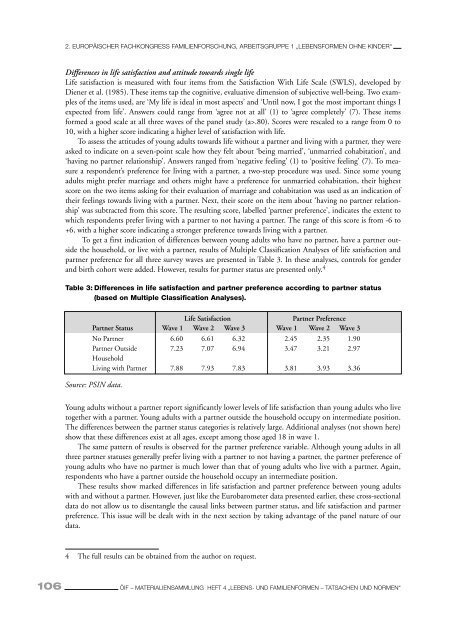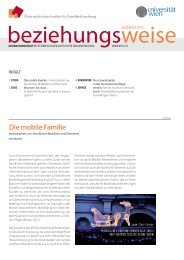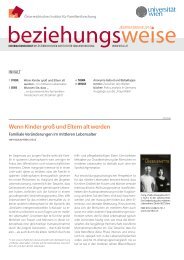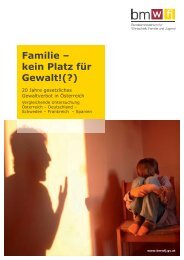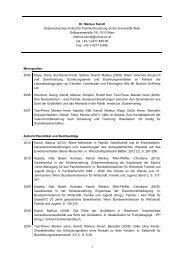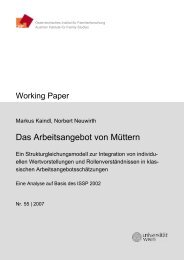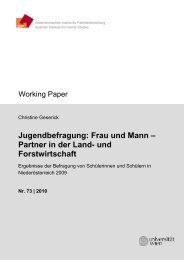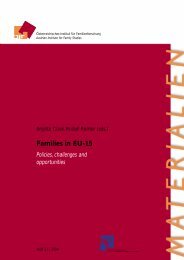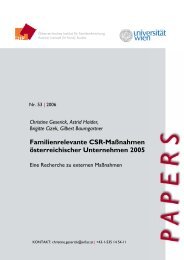Lebens- und Familienformen - Tatsachen und Normen
Lebens- und Familienformen - Tatsachen und Normen
Lebens- und Familienformen - Tatsachen und Normen
Sie wollen auch ein ePaper? Erhöhen Sie die Reichweite Ihrer Titel.
YUMPU macht aus Druck-PDFs automatisch weboptimierte ePaper, die Google liebt.
2. EUROPÄISCHER FACHKONGRESS FAMILIENFORSCHUNG, ARBEITSGRUPPE 1 „LEBENSFORMEN OHNE KINDER“<br />
Differences in life satisfaction and attitude towards single life<br />
Life satisfaction is measured with four items from the Satisfaction With Life Scale (SWLS), developed by<br />
Diener et al. (1985). These items tap the cognitive, evaluative dimension of subjective well-being. Two examples<br />
of the items used, are ‘My life is ideal in most aspects’ and ‘Until now, I got the most important things I<br />
expected from life’. Answers could range from ‘agree not at all’ (1) to ‘agree completely’ (7). These items<br />
formed a good scale at all three waves of the panel study (a>.80). Scores were rescaled to a range from 0 to<br />
10, with a higher score indicating a higher level of satisfaction with life.<br />
To assess the attitudes of young adults towards life without a partner and living with a partner, they were<br />
asked to indicate on a seven-point scale how they felt about ‘being married’, ‘unmarried cohabitation’, and<br />
‘having no partner relationship’. Answers ranged from ‘negative feeling’ (1) to ‘positive feeling’ (7). To measure<br />
a respondent’s preference for living with a partner, a two-step procedure was used. Since some young<br />
adults might prefer marriage and others might have a preference for unmarried cohabitation, their highest<br />
score on the two items asking for their evaluation of marriage and cohabitation was used as an indication of<br />
their feelings towards living with a partner. Next, their score on the item about ‘having no partner relationship’<br />
was subtracted from this score. The resulting score, labelled ‘partner preference’, indicates the extent to<br />
which respondents prefer living with a partner to not having a partner. The range of this score is from -6 to<br />
+6, with a higher score indicating a stronger preference towards living with a partner.<br />
To get a first indication of differences between young adults who have no partner, have a partner outside<br />
the household, or live with a partner, results of Multiple Classification Analyses of life satisfaction and<br />
partner preference for all three survey waves are presented in Table 3. In these analyses, controls for gender<br />
and birth cohort were added. However, results for partner status are presented only. 4<br />
Table 3: Differences in life satisfaction and partner preference according to partner status<br />
(based on Multiple Classification Analyses).<br />
Life Satisfaction<br />
Partner Preference<br />
Partner Status Wave 1 Wave 2 Wave 3 Wave 1 Wave 2 Wave 3<br />
No Partner 6.60 6.61 6.32 2.45 2.35 1.90<br />
Partner Outside 7.23 7.07 6.94 3.47 3.21 2.97<br />
Household<br />
Living with Partner 7.88 7.93 7.83 3.81 3.93 3.36<br />
Source: PSIN data.<br />
Young adults without a partner report significantly lower levels of life satisfaction than young adults who live<br />
together with a partner. Young adults with a partner outside the household occupy on intermediate position.<br />
The differences between the partner status categories is relatively large. Additional analyses (not shown here)<br />
show that these differences exist at all ages, except among those aged 18 in wave 1.<br />
The same pattern of results is observed for the partner preference variable. Although young adults in all<br />
three partner statuses generally prefer living with a partner to not having a partner, the partner preference of<br />
young adults who have no partner is much lower than that of young adults who live with a partner. Again,<br />
respondents who have a partner outside the household occupy an intermediate position.<br />
These results show marked differences in life satisfaction and partner preference between young adults<br />
with and without a partner. However, just like the Eurobarometer data presented earlier, these cross-sectional<br />
data do not allow us to disentangle the causal links between partner status, and life satisfaction and partner<br />
preference. This issue will be dealt with in the next section by taking advantage of the panel nature of our<br />
data.<br />
4 The full results can be obtained from the author on request.<br />
106<br />
ÖIF – MATERIALIENSAMMLUNG HEFT 4 „LEBENS- UND FAMILIENFORMEN – TATSACHEN UND NORMEN“


